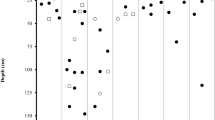Summary
The structure and thermal environment produced by the nest cones of the western harvester ant,Pogonomyrmex occidentalis, are investigated. The nest cone is oriented so that the longest slope faces towards the southeast ad the nest entrance faces the southeast. The temperature of the soil was monitored at thirty-six locations within the nest in order to measure the daily temperature change as a function of depth, aspect and radial distance from the center of peak of the cone. The occupancy of the nest cone by workers and by brood was assessed by core samples taken at different times of day in different portions of the cone. The brood are only present during the midmorning sample and are present in greatest numbers on the eastern side of the cone. The adult workers are present in the cone in highest numbers during the midmorning, virtually absent from the cone during mid-afternoon and returning in smaller numbers at dusk, apparently spending the night near the surface on the eastern side of the mound. The eastern and southern portions of the cone are occupied most frequently while the western side of the cone is nearly vacant. The nest cone is an adaptation which magnifies the amplitude of daily temperature fluctation. By moving to appropriate areas of the nest cone, the ants can take advantage of the increased range of temperature.
Similar content being viewed by others
References
Coenen-Stass, D., B. Schaarschmidt and I. Lamprecht. 1980. Temperature distribution and calori-metric determination of heat production in the nest of the wood ant,Formica polyctena (Hymenoptera, Formicidae).Ecology 61:238–244.
Dlussky, G. 1981. Muravé Pustin (Desert ants). Academy of Sciences, USSR. Moscow society for investigations of nature, Zoological section. Moscow, pp. 229. (in Russian).
Gay, F. and J. Calaby. 1970. Termites of the Australian region. In: Biology of Termites, (K. Kumar and F. Weesner, Eds), pp. 393–448.
Hölldobler, B. 1976. Recruitment behavior, home range orientation and territoriality in harvester ants,Pogonomyrmex.Behav. Ecol. and Sociobiol. 1:3–44.
Hölldobler, B. and E. O. Wilson. 1990. The Ants. The Belknap Press of Harvard University Press, Cambridge, Mass. pp. 732.
Horstmann, K. and H. Schmid. 1986. Temperature regulation in the nest of the wood ant,Formica polyctena (Hymenoptera: Formicidae).Entomol. Gen. 11:229–236.
Lavigne, R. J. 1969. Bionomics and nest structure ofPogonomyrmex occidentalis (Hymenoptera: Formicidae).Ann. Ent. Soc. U.S.A. 62:1166–1175.
McCook, H. C. 1882. The Honey Ants of the Garden of the Gods and the Occident Ants of the American Plains. J. B. Lippincott and Co. Philadelphia, pp. 188.
MacKay, E. and W. MacKay. 1984. Biology of the thatching antFormica haemorrhoidalis Emery (Hymenoptera: Formicidae).Pan-Pacific Entomolgist 60:79–87.
MacKay, W. and E. MacKay. 1985. Temperature modifications of the nest ofPogonomyrmex montanus (Hymenoptera: Formicidae).Southwestern Naturalist 30:307–309.
Noirot, C. 1970. The nests of termites. In: Biology of Termites (K. Kumar and F. Weesner, Eds.), pp. 73–125.
Rosengren, R., W. Fortelius, K. Lindstrom and A. Luther. 1986. Phenology and causation of nest heating and thermoregulation in red wood ants of theFormica rufa group studied in coniferous forest habitats in southern Finland.Annales Zoologici Fennici 24:147–155.
Seeley, T. 1985. Honeybee ecology: a study of adaptation in social life. Princeton Monographs in Behavior and Ecology. Princeton Univ. Press, Princeton, N.J, pp. 201.
Wehner, R., A. Marsh and S. Wehner. 1992. Desert ants on a thermal tightrope.Nature 357:586–587.
Wheeler, G.C. and J.N. Wheeler. 1986. The Ants of Nevada. The Natural History Museum of Los Angeles County, pp. 138.
Author information
Authors and Affiliations
Rights and permissions
About this article
Cite this article
Cole, B.J. Nest architecture in the western harvester ant,Pogonomyrmex occidentalis (Cresson). Ins. Soc 41, 401–410 (1994). https://doi.org/10.1007/BF01240643
Received:
Revised:
Accepted:
Issue Date:
DOI: https://doi.org/10.1007/BF01240643




